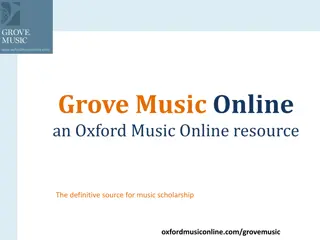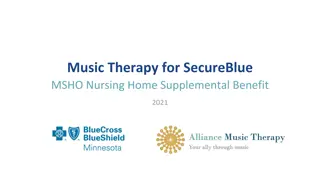Transforming Communities through the Power of Music
Explore the profound impact of music on individuals, communities, and the world at large. Delve into the healing properties, cultural significance, and transformative abilities of music as shared through personal experiences and global examples. Discover how music has the capacity to forge connections, incite positive change, and elevate the human experience.
Download Presentation

Please find below an Image/Link to download the presentation.
The content on the website is provided AS IS for your information and personal use only. It may not be sold, licensed, or shared on other websites without obtaining consent from the author. Download presentation by click this link. If you encounter any issues during the download, it is possible that the publisher has removed the file from their server.
E N D
Presentation Transcript
Delivered by Rachel Dempsey for Lourdes Youth & Community Servicers Development Education& Global Harmonies 14thJune 2016
Write a list of the things you see happening in the world (local & global) that give you HOPE Write a list of the things that WORRYyou. Share in small groups
What are your thoughts on the role of music in transforming the world (individual lives, communities and the globe in general) for the better? What can it do? What can t it do? Watch: Simon Broughton TED talk: https://www.youtube.com/watch?v=kfQF6fF4kRI
"We believe music has the ability to heal the community, the partnership, and the individual. It is a multi-tiered cultural experience that brings people together by forging a common tongue and common experience. New and ancient, it is a language of unity and deep recognition to all the corners of the globe. It creates dance space, listening space, and harmonic space for the listeners and the creators. It forges relationships between the people in our lives and between the cells in our bodies... strengthening what is already there and supplementing what is perhaps missing. Music leans into people's daily existence and opens us all up to the poetry of life." ~ Chloe, singer from Raising Appalachia
Community/Youth Music e.g. Olodum in Brazil Community Music Therapy Music Therapy (Western/Medical) Music in healing (traditional practices e.g. shamanism) Sound healing (Western/Alternative) Protest Song Music in public awareness campaigns e.g. health campaigns in Africa Music in religious/spiritual practices
Group hums or makes vowel sound together Toning is defined as - 'to make sound with an elongated vowel for an extended period'. Toning vowel sounds is an easily learnt skill. Toning oxygenates the body, deepens breathing, relaxes muscles and stimulates the whole body. Regular toning helps to restore health to the mind, body and spirit. Toning together with other people will give us a feeling of connection; it can also help us to release stress and repressed emotions. Toning strengthens the vocal muscles. It assists in improving our breathing and posture. The muscles of the digestive system are massaged and stimulated by regular toning. Toning can relax and energise us at the same time. The human voice has a vast potential for healing. All of us have the ability to create pure tone and vocal harmonics. When we first learn to speak we have a wide vocal range, as we grow older our voice begins to become more restricted and closed. Research suggests that toning has a neurochemical effect on the body, boosting the immune system and causing the release of endorphins in the brain. Toning can release psychological stress before surgery, lower the blood pressure and respiratory rate of cardiac patients, it can also reduce tension in those undergoing MRI and CAT scans. Read more http://www.simonheather.co.uk/pages/chapters/thehealingoowerofsound_sample.pdf
Singing and chocolate Singing and the gym Singing and breastfeeding Singing and morphine
Sound in water https://www.youtube.com/watch?v=uENITui5_jU Chlandi https://www.youtube.com/watch?v=wMIvAsZvBiw https://www.youtube.com/watch?v=wYoxOJDrZzw Break class with sound https://www.youtube.com/watch?v=rRZT7xO5KN4
Music & singing affect hormones, heart rate, pulse rate, blood pressure, brain waves, immune function, mood, memory, learning, performance, behaviour improves posture & confidence is a form of aerobic exercise, especially for heart, lungs and core (abs) alleviates or lessens pain lowers heart rate variability (HRV), linked to reduced risk of heart disease. can train lungs to breathe better boosts our immune system, may kill cancer cells can increase life expectancy Of all types of singing, choral/group singing is proven to be the most beneficial Our heartbeats synchronise when we sing together (entrainment)
reduces stress levels (cortisol) increases endorphin (feel good hormone) levels can help reduce anger, depression and anxiety helps access memories (e.g. dementia sufferers) Increased sense of community, belonging and shared purpose Builds motivation, confidence, energy levels Oxytocin - a bonding hormone produced by the brain that contributes to feelings of trust, generosity, compassion, kindness, caring and empathy for the people around you - is released during singing
Form of meditation Can be used to alter state of consciousness Many religions use chant (and song, music) to access the spiritual realm e.g. encourage possession (Yoruba religion) or travel to spirit world (shamans). Brings resonance and vibration to the whole body (and energy body too) Clears
The Singing Revolution is a commonly used name for events between 1987 and 1991 that led to the restoration of the independence of Estonia, Latvia and Lithuania.Includes of Estonians gathering on June 10 11, 1988, spontaneous mass night-singing demonstrations at theTallinnSong Festival Grounds. https://www.youtube.com/watch?v=DA9Pm Zo-2jo
In 1930s in Brazil, populist dictator Getulio Vargas promoted samba as Brazil s true national rhythm Before this was persecuted due to its lowly African, lascivious nature Was chosen as was seen as a perfect blend of European (Portuguese) and African, the same as the people.
Music as a form of social critique, resistance, and information has a long and wealthy tradition in Latin America. The 1960s saw a flourishing of music that questioned the established order. This was called Nueva Cancion Victor Jara, prominent Chilean protest singer was killed in 1973 after Pinochet s coup. Many others from all over LA were exiled.
I don't sing for love of singing, or because I have a good voice. I sing because my guitar hasboth feeling and reason. It has a heart of earth and the wings of a dove, it is like holy water, blessing joy and grief. My song has found a purpose asVioleta would say. Hardworking guitar, with a smell of spring. My song is of the ladder we are building to reach the stars. For a song has meaning when it beats in the veins of a man who will die singing, truthfully singing his song. My song is not for fleeting praise nor to gain foreign fame, it is for this narrow country to the very depths of the earth. There, where everything comes to rest and where everything begins, the song which has been brave willbe forever new. My guitar is not for the rich no, nothing like that.
Vimbuza is a healing dance popular among the Tumbuka people living in northern Malawi. It is an important manifestation of the ng oma, a healing tradition found throughout Bantu-speaking Africa. Ng oma, meaning drums of affliction , carries considerable historical depth and, despite various attempts over the years to suppress it, remains a fundamental part of indigenous healthcare systems. Most patients are women who suffer from various forms of mental illness. They are treated for some weeks or months by renowned healers who run a temphiri, a village house where patients are accommodated. After being diagnosed, patients undergo a healing ritual. For this purpose, women and children of the village form a circle around the patient, who slowly enters into a trance, and sing songs to call helping spirits. The only men taking part are those who beat spirit-specific drum rhythms and, in some cases, a male healer. Singing and drumming combine to create a powerful experience, providing a space for patients to dance their disease . Its continually expanding repertoire of songs and complex drumming, and the virtuosity of the dancing are all part of the rich cultural heritage of the Tumbuka people. The Vimbuza healing ritual goes back to the mid-nineteenth century, when it developed as a means of overcoming traumatic experiences of oppression, and it further developed as a healing dance under British occupation, although it was forbidden by Christian missionaries. By becoming possessed by Vimbuza spirits, people could express these mental problems in a way that was accepted and understood by the surrounding society. For the Tumbuka,Vimbuza has artistic value and a therapeutic function that complements other forms of medical treatment. Vimbuza is still practised in rural areas where the Tumbuku live, but it continues to face oppression by Christian churches and modern medicine.
On YouTube you can find my playlist of videos Transforming Our Worlds through Music . You ll find Syrian protest song, videos of the Baka people in the Central African rainforest, Latin America hip hop, Aboriginal Australian music, Sing for the Climate, Playing for Change film featuring Omagh Community Youth Choir, Malian TikenJay Fakoly s song No to Female Genital Mutilation and more. https://www.youtube.com/playlist?list=PLE_rL4Mp EOofMlhRVcT9yaLZiAjS1QhY3















![The Exciting World of Live Music Through [Insert Town/City] Census!](/thumb/148894/the-exciting-world-of-live-music-through-insert-town-city-census.jpg)













